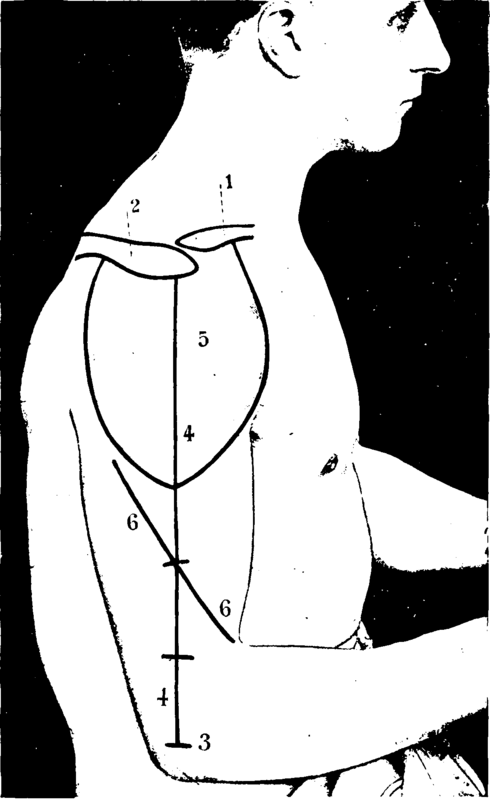The Shoulder And Arm
Description
This section is from the book "Landmarks And Surface Markings Of The Human Body", by Louis Bathe Rawling. Also available from Amazon: Landmarks and Surface Markings of the Human Body.
The Shoulder And Arm
The musculo-cutaneous nerve usually pierces the inner aspect of the coraco-brachialis muscle about 1 to 2 inches below the coracoid process. It then runs downwards and outwards, deep to the biceps muscle, towards the outer bicipital sulcus, at which level it becomes cutaneous. The course of the nerve in the arm can, therefore, be roughly indicated by a line from the coracoid process above to the outer bicipital sulcus below.
The musculo-spiral nerve, accompanied by the anterior branch of the superior profunda artery, (Fig. XIII, 6., Fig. XIV, 6. ) pierces the external intermuscular septum of the arm, from behind forwards, at the junction of the upper and middle thirds of a line drawn from the insertion of the deltoid muscle to the external condyle of the humerus. Below this point the nerve passes downwards and inwards to the outer bicipital sulcus, where it bifurcates into its two terminal branches. Above the point at which the nerve pierces the external intermuscular septum, the course of the nerve may be represented by a curved line drawn upwards and inwards to the junction of the upper arm with the posterior fold of the axilla.
The radial nerve, a branch of the musculo-spiral, (Fig. VI, 16., Fig. XIII, 10.) arises in the outer bicipital sulcus, and passes vertically down the forearm, accompanying, and lying to the outer side of, the radial artery in its middle third. At the junction of the middle and lower thirds of the forearm, the nerve turns round the outer border of the radius under cover of the supinator longus tendon, to be distributed to the back of the wrist and hand.
The posterior interosseous nerve arises from the musculo-spiral in the outer bicipital sulcus, (Fig. XIII, 9.) and curls round the neck of the radius in the substance of the supinator brevis muscle, emerging from the posterior border of that muscle 2 inches below the head of the radius. It then passes vertically down the posterior aspect of the forearm, lying about midway between the inner and outer borders, and terminating in a gangliform enlargement at the posterior aspect of the wrist.

1. The clavicle.
2. The acromion process.
3. The external condyle of the humerus.
4. Hamilton's line.
5. The deltoid muscle.
6. The musculo-spiral nerve.
Continue to:
